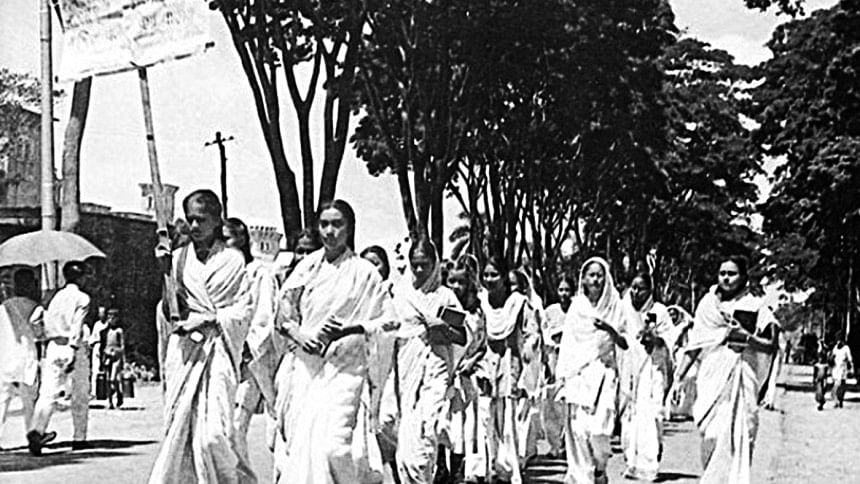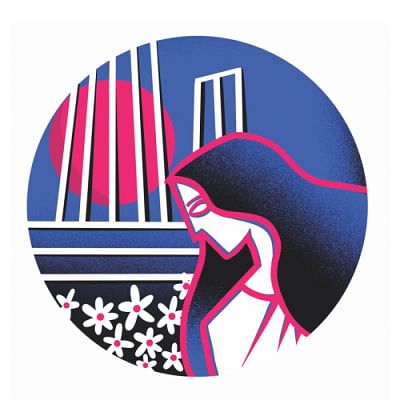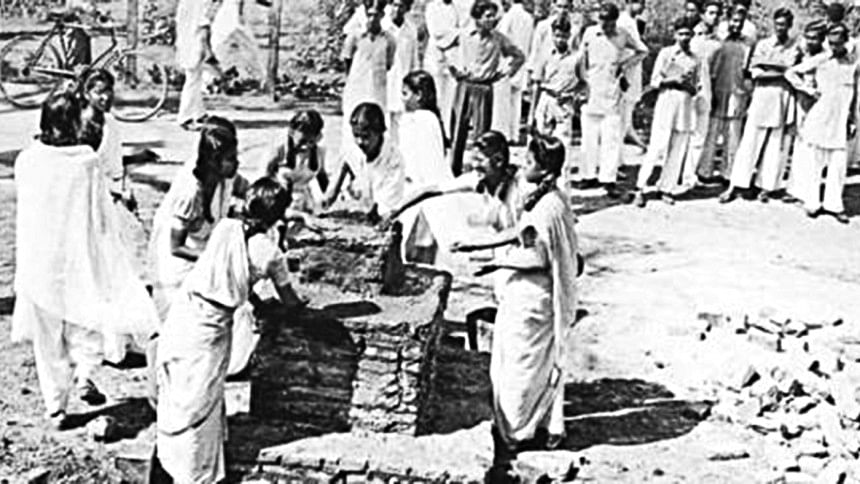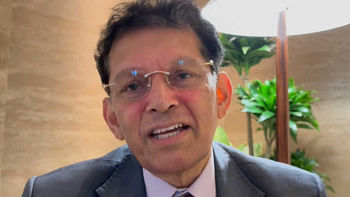The women who broke the barricades


The Language Movement is an indelible incident in the history of the Bengali nation and Bangla language. It took decades of effort, sacrifice and endurance of our forefathers to bring Bangla to the doorstep of 1952.
The chronological history of it all cannot be described in this small article. I would like to begin my discussion of the journey of our language from 1947—from the inception of Pakistan. Immediately after the creation of an independent Pakistan, a cultural organisation named Tamaddun Majlish was formed on September 1 under the leadership of Abul Kashem, a young professor at the University of Dhaka (DU) back then. The organisation's office was situated in Building no. 19 in the Azimpur residential area. Its main purpose was to explore new avenues in forging a national identity in line with the culture and customs of the nation. As the first step towards the goal, the Majlish chose to secure the recognition of Bangla as a state language from the ruling class. To accelerate its demand, Tamaddun Majlish, in no time, published a pamphlet authored by three scholars. The publication of the pamphlet caused quite a stir in the conscious section of society.
I was a seventh grader back then. Bangla is our native language; we speak in this language. We were elated to know that Bangla was going to be a state language. We were acquainted with Professor Abul Kashem. Making use of this opportunity, my sister Momtaj and I became activists of the Majlish. We would often visit the office on weekends and help the seniors in various activities, which included making posters and banners. We even saw a handful of women visiting the office. Among them were Jebunnisa Begum, Doulatunnesa Begum, and Anwara Begum. All of them had attained higher education. These women believed in the ideology of the Majlish and were outspoken on the issue of language.

Women, unlike today, did not have freedom of movement back then. Their lives were saddled with many barriers. The practice of general education was very limited for the women who came from conservative Muslim families. They were mainly taught Urdu, Arabic, and Persian languages. Surprisingly, soon after the establishment of the new state, a wave of renaissance hit the Muslim girls across the country. The female enrolment rate in schools and colleges began increasing. Parents became more interested in providing their girls with the opportunities of higher education. This eventually resulted in an increasing number of female students at DU. The number of Muslim female students there was very insignificant before an independent country was established.
The Language Movement reached its peak between 1947 and 1951 when the number of female students at DU was around 80. These girls played a glorious role in the movement by joining shoulder to shoulder with their male counterparts. Dr Safia Khatun was the general secretary of Dhaka University Women Hall Union in 1951-52, and she became the vice president of the union in 1952-53. Under her leadership, female students of the university went to schools and colleges and encouraged students there to take part in the movement.
The female students of this period who made their place in the history are Sufia Khatun (daughter of Justice Ibrahim), Shamsun Nahar, Rawshan Ara Bachchu, Sara Taifoor, Kazi Amina, Mahfil Ara, Khurshidi Khanam, and Halima Khatun.
Anwara Khatun was a prominent figure among those who were not a part of DU but were involved with the Tamaddun Majlish. She was a member of the provincial council and a distinguished member of the Rashtrabhasha Sangram Parishad formed in 1952. Gaibandha's Doulatunnesa, a member of the provincial council in 1954, was another trailblazer. Names of Nadera Begum, Hamida Khatun, Nurjahan Murshid, Afsari Khanam, Ranu Mukherjee and Lili Haque also shine through in the history of the Language Movement. Begum Sufia Kamal and Nurjahan Murshid led a rally protesting the brutality of February 21.
Begum Doulatunnesa too led a protest procession. A proposal for condemnation of the shooting on protesters during a February 28 procession was accepted under the leadership of Nurjahan Murshid and Layla Khanam. Subsequently, Lulu Bilkis Banu and others joined the movement. One Hamida Selim Rahman from Jashore wrote an article in defence of Bangla, which was published in the daily Azad in 1947. She became the joint secretary of Rashtrabhasha Sangram Parishad. Headmistress of Narayanganj Morgan School Momtaj Begum led the local movements demanding Bangla's recognition as a state language.
Girls from Sylhet also took part in the Language Movement in 1948 and sent a delegation to the then Prime Minister Khawaja Nazimuddin, led by Zobeda Khatun Chowdhurani, who was a leader of the Muslim League in Sylhet.
Chattogram has always played a pioneering role when needed for the country and the nation.
A number of female college students and women in Chattogram including Tohfatunnesa Azim, Syeda Halima, Sultana Begum, Nurunnahar Jahur, Ainun Nahar, Anwara Mahfuz, Taleya Rahman and Pratibha Mutsuddi were involved with the movement. In Khulna, activists of Tamaddun Majlish including Anwara Begum and Sajeda Ali, and many female students of schools and colleges participated in various activities.
In Satkhira, Gul Ara Begum and Sultana Chowdhury actively took part in the movement. So did Nurunnahar Belly and Rowshan Ara Sharif in Tangail. Women in Rangpur including Nilufa Ahmed, Begum Maleka Ashraf and Aftabunnesa brought out a procession protesting the shooting incident. Dr Jahanara Begum Benu, Monowara Begum Benu, Dr Mohsina Begum, Firoza Begum Funu, Hafiza Begum Tuku, Hasina Begum Doli, Rowshan Ara, Khurshida Banoo Khuku, Akhter Banu were some of the renowned figures who played a significant role in Rajshahi.
The story of three women—Rahela Khatun, Rahima Khatun, and Rokeya Begum—has been shrouded in history of the Language Movement. Working out of Azimpur No. 19, they never took part in any meetings or processions but were a source of inspiration for many rebellious youths of Tamaddun Majlish. Rahela was the wife of Abul Kashem's brother-in-law. She sacrificed her comfort throughout her life, honouring her husband's work and ideology. Rokeya used to help the former cook food for 20 to 30 people every day with a smile on her face, while Rahima joined them during the nights. These women barely had the opportunity to sleep before 2 am.
Despite the difficulties, these three women devoted themselves to the movement. They put aside their physical and mental peace to ensure uninterrupted service for the expatriate activists of the Majlish. I heard from Gafur bhai that many people were imprisoned on February 22-23 in a police crackdown. When the police came to the Azimpur house that night, Rahela gallantly faced them and kept them busy at the entrance allowing [Abdul] Gafur bhai and [Abul] Kashem bhai to escape through the backdoor. The women were the driving force of the Language Movement and set it in motion with their love, affection, and bravery.
Apart from the aforementioned women, we came to learn about the contribution of others from an interview of Ataur Rahman. Two or three days after February 21, a few of them went to the Azimpur colony to collect contributions for the Language Movement. Many women donated their precious gold jewellery, including rings, earrings and necklaces. He was overwhelmed after seeing the women's love for the language at that time. This was when a sense of self and individuality among women began to take root; this awareness was part of a cultural and political awakening that laid the foundation of our independence.
Given all this sacrifice, the shabby state of Bangla now makes me disconsolate. The urge we felt to protect our independence, nationality, and culture cannot be seen in the practice of Bangla language today. The values that shaped the Language Movement are slowly eroding. The demand for Bangla at all levels of the state is relegated to sloganeering. Over the years, Bangla has been subjected to arbitrary inclusions from other languages, which served to corrupt its purity. In the process, the language has lost its melody. It was further plagued by whimsical usage of different spellings, which has made the language more ambiguous and subject to controversy. Therefore, it is my humble request to those receiving the Ekushey Padak that they take bold measures in an attempt to continue the perpetual flow of practical Bangla usage.
Chemon Ara was was a passionate advocate of the Language Movement as well as the women's rights movement. During the Language Movement of 1952, Chemon Ara was a second year student of Eden College and played an active part in it.
Translated from Bangla by Shahriar Sajib.

 For all latest news, follow The Daily Star's Google News channel.
For all latest news, follow The Daily Star's Google News channel. 



Comments